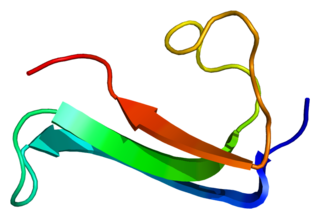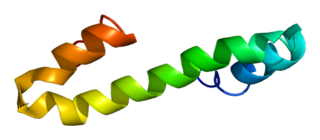
Neural cell adhesion molecule (NCAM), also called CD56, is a homophilic binding glycoprotein expressed on the surface of neurons, glia and skeletal muscle. Although CD56 is often considered a marker of neural lineage commitment due to its discovery site, CD56 expression is also found in, among others, the hematopoietic system. Here, the expression of CD56 is mostly associated with, but not limited to, natural killer cells. CD56 has been detected on other lymphoid cells, including gamma delta (γδ) Τ cells and activated CD8+ T cells, as well as on dendritic cells. NCAM has been implicated as having a role in cell–cell adhesion, neurite outgrowth, synaptic plasticity, and learning and memory.
A neurite or neuronal process refers to any projection from the cell body of a neuron. This projection can be either an axon or a dendrite. The term is frequently used when speaking of immature or developing neurons, especially of cells in culture, because it can be difficult to tell axons from dendrites before differentiation is complete.

Pleiotrophin (PTN) also known as heparin-binding brain mitogen (HBBM) or heparin-binding growth factor 8 (HBGF-8) or neurite growth-promoting factor 1 (NEGF1) or heparin affinity regulatory peptide (HARP) or heparin binding growth associated molecule (HB-GAM) is a protein that in humans is encoded by the PTN gene. Pleiotrophin is an 18-kDa growth factor that has a high affinity for heparin. It is structurally related to midkine and retinoic acid induced heparin-binding protein.

Betulinic acid is a naturally occurring pentacyclic triterpenoid which has antiretroviral, antimalarial, and anti-inflammatory properties, as well as a more recently discovered potential as an anticancer agent, by inhibition of topoisomerase. It is found in the bark of several species of plants, principally the white birch from which it gets its name, but also the ber tree, selfheal, the tropical carnivorous plants Triphyophyllum peltatum and Ancistrocladus heyneanus, Diospyros leucomelas, a member of the persimmon family, Tetracera boiviniana, the jambul, flowering quince, rosemary, and Pulsatilla chinensis.

Midkine, also known as neurite growth-promoting factor 2 (NEGF2), is a protein that in humans is encoded by the MDK gene.

The subcommissural organ (SCO) is one of the circumventricular organs of the brain. It is a small glandular structure that is located in the posterior region of the third ventricle, near the entrance of the cerebral aqueduct.

Reticulon 4, also known as Neurite outgrowth inhibitor or Nogo, is a protein that in humans is encoded by the RTN4 gene that has been identified as an inhibitor of neurite outgrowth specific to the central nervous system. During neural development Nogo is expressed mainly by neurons and provides an inhibitory signal for the migration and sprouting of CNS endothelial (tip) cells, thereby restricting blood vessel density.

Dock3, also known as MOCA and PBP, is a large protein involved in intracellular signalling networks. It is a member of the DOCK-B subfamily of the DOCK family of guanine nucleotide exchange factors (GEFs) which function as activators of small G proteins. Dock3 specifically activates the small G protein Rac.

Protocatechuic acid (PCA) is a dihydroxybenzoic acid, a type of phenolic acid. It is a major metabolite of antioxidant polyphenols found in green tea. It has mixed effects on normal and cancer cells in in vitro and in vivo studies.

Nantenine is an alkaloid found in the plant Nandina domestica as well as some Corydalis species. It is an antagonist of both the α1-adrenergic receptor and the serotonin 5-HT2A receptor, and blocks both the behavioral and physiological effects of MDMA in animals.

Nobiletin is a flavonoid isolated from citrus peels. It is an O-methylated flavone that has the activity to rescue bulbectomy-induced memory impairment.

Taxifolin (5,7,3',4'-flavan-on-ol), also known as dihydroquercetin, belongs to the subclass flavanonols in the flavonoids, which in turn is a class of polyphenols.

Merrilactone A is one of the four sesquiterpenes that were newly discovered from the fruit of Illicium merrillianum in 2000. Members of the genus Illicium include Chinese star anise, widely used as a spice for flavouring food and beverages, and also poisonous plants such as Japanese star anise. Chemical studies of Illicium have developed rapidly over the last 20 years, and merrilactone A has been shown to have neurotrophic activity in fetal rat cortical neuron cultures. This has led researchers to believe that Merrilactone A may hold therapeutic potential in the treatment of neuro-degenerative diseases such as Alzheimer's disease and Parkinson's disease.
Cāng zhú, also known as black atractylodes rhizome or Rhizoma Atractylodes, is a Chinese herbal medicine. It is the dried rhizome of Atractylodes lancea (Thunb.) DC., Atractylodes chinensis (DC.) Koidz, or certain other local species including Atractylodes japonica Koidz. The medicine is distinguished from bái zhú, which is typically cultivated, whereas cāng zhú more often tends to be collected from the wild. It is believed that the distinction between cāng zhú and bái zhú emerged in relatively modern times; a single drug "zhú" described in the Shen nong ben cao jing probably included many Atractylodes species.

Capnellene is a naturally occurring tricyclic hydrocarbon derived from Capnella imbricata, a species of soft coral found in Indonesia. Since the 1970s, capnellene has been targeted for synthesis by numerous investigators due to its stereochemistry, functionality, and the interesting geometry of the carbon skeleton. Many alcohol derivatives of capnellene have demonstrated potential as a chemotherapeutic agent with antibacterial, anti-inflammatory and anti-tumor properties.
Elemenes are a group of closely related natural chemical compounds found in a variety of plants. The elemenes, which include α-, β-, γ-, and δ-elemene, are structural isomers of each other and are classified as sesquiterpenes. The elemenes contribute to the floral aromas of some plants, and are used as pheromones by some insects.

Eudistomins are β-carboline derivatives, isolated from ascidians, like Ritterella sigillinoides, Lissoclinum fragile, or Pseudodistoma aureum.

Antillatoxin (ATX) is a potent lipopeptide neurotoxin produced by the marine cyanobacterium Lyngbya majuscula. ATX activates voltage-gated sodium channels, which can cause cell depolarisation, NMDA-receptor overactivity, excess calcium influx and neuronal necrosis.

Anicequol is a naturally occurring ergostane or lanostane steroid produced by Acremonium sp. TF-0356 which has nerve growth factor-like neurotrophic activity. It was under investigation by Taisho Pharmaceutical in Japan for the treatment of cognitive disorders in the 1990s, but development was discontinued and the drug was never marketed.

C286, is a potent, orally bioavailable retinoic acid receptor beta (RARβ) agonist with good selectivity over the RARα, and RARγ receptors. This molecule increases neurite outgrowth in vitro and stimulates sensory axon regrowth in vivo in a rodent model of crush and avulsion injury, and is being evaluated for the treatment of nerve injury.

















